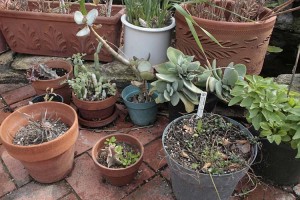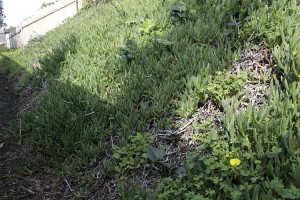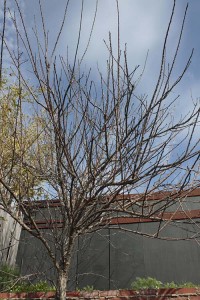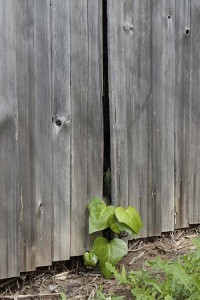Ever wonder what your garden would look like if the human caretakers just vanished?
Maybe I’ve been inspired by all the disaster flicks like 2012 or the History Channel’s Life After People series. But envisioning gardens after gardeners is an interesting intellectual exercise that might help us answer that pesky question: What is a garden?
Would all the invasive species take over? Would the native plants reclaim their turf? For how long would you still be able to tell that a garden existed in a spot in the first place?
I looked at parts of my back yard and tried to imagine what would happen.
Within the first month, in Southern California’s dry climate, most of the potted plants would perish for lack of water. Some of the succulents might hang on longer, but without an extensive root system in the ground, they’d be doomed.
This little frog would be staring at a bog garden where all the bog plants have died back, once again for lack of water.
Within two or three months the fishponds would be dry: no waterlilies, no cattails, no sedges, no water for the local birds.
This pathetic patch of grass would go through boom and bust cycles, turning green with the rains, dying back to brown other times of year. Seeds of other plants better adapted to the conditions would eventually take hold. Maybe some plants from the local canyon. Maybe some hardy exotic or invasive species.
Behind the back fence of the house is this slope dominated by rampant iceplant. The the neighbor behind me and I haven’t been able agree on what to do with the space. I’ve planted a small collection of native plants to help stabilize the slope. These are species that with only once exception can be found within a five mile radius of the house, and include plants like this nightshade, Solanum parishii…
…and Del Mar Manzanita, Arctostaphylos glandulosa ssp. crassifolia, an extremely rare plant that’s on the Federal endangered species list. The neighbor, however, loves their iceplant and can’t imagine of a slope without this gawdawful invasive species clamoring all over it. The local chapter of the California Native Plant Society has prepared a great pamphlet on getting rid of iceplant that you can view [ here ]. It goes into some great reasons to get rid of the stuff:
Planted on hillsides of thousands of homes in San Diego, it has since crawled off the original site and into neighboring Open Space parks, endangering unique plants by smothering them. Iceplant provides little habitat value compared to the plant community that it is replacing. Compared to the native shrubs, iceplant has very shallow roots that do not hold soil well; close inspection often reveals gullies underneath the twisted mat of vines. After rain, Iceplant engorges with water, substantially increasing its weight. As a result, iceplant can cause the deterioration of steep hillsides by encouraging slumping – potentially endangering the house above.
For people in suburbia, “habitat value” might mean plants that harbor scary wild animals and bugs, so that’s not always the most compelling reason to go native. The fact that iceplant might endanger their property values could be more persuasive.
So, returning to my main topic, the iceplant would probably overrun most of the native plants in a very few years and form a deep pile. Once we neglected the slope for a few years and found that the mat of iceplant was starting to push the back fence over. Within ten years the fence would begin to fail and the iceplant would begin its descent into the lower garden.
These plants along the back fence would stand a chance of surviving without water. The yucca, palm, protea would be tall enough to survive an onslaught of marauding iceplant from behind. They’re plants that don’t require much maintenance, and this wall of foliage would probably look unchanged for a number of years. But the lower aloes and other succulents would likely be smothered by the iceplant.
This apricot against the back fence never looks great without summer watering, but it survives. It’s tall enough that it would probably survive the iceplant invasion. Some of the adjacent native plants do great with the natural conditions. They might not cope so well with the marauding iceplant.
The neighbor on the side has Algerian ivy that requires constant clipping to keep it next door. Within two years it would begin to establish itself in the back yard. Taller plants that might survive the iceplant invasion might have ivy crawling up and smothering them.
This raised bed near the house is where veggies and irrigated plants live. Most of the exotic plants wouldn’t make it without water. The Dr. Hurd manzanita, the bougainvillea vine and maybe the Garrya elliptica would probably hang in there, however, maybe for decades, maybe for much longer.
Fifty to seventy-five years out the house would start to fail. Plants might begin to move in. The surrounding garden space would be overgrown with the hardiest drought-adapted species. I almost never plant in rows, but the mixed origins of the species–South Africa, South America, Europe, as well as from all over California, not just local species–would clue an investigator into the fact that a garden existed on the site. The relationships between the plants would be dictated by nature, not a gardener preserving order between plants with mismatched levels of vigor.
Chances are excellent that one hundred years out, maybe two hundred or more, the most persistent invasive species would still be here. Iceplant and ivy, plus fennel and black mustard that have invaded the local canyons, would feature in the neighborhood landscape. But while many invasives bask in the newly disturbed earth of a garden or the re-engineered grades around roads, they don’t always do so well long-term. Biologists have suggested that many native plants would return to a place where they’re not being pulled out or constantly mowed. My yard might be colonized by the local Mexican elderberry, or toyon, or lemonade berry, or prickly pear. And maybe some of the plants I’ve already introduced to the yard will persist and reproduce. The restoration of nature might spread from my house and from the wild edges of nature just a few houses away.
Even after nature returns, the occasional hardy exotic plant surviving amidst the natives, along with some of the neighborhood’s plantings of trees and shrubs in rows will make it obvious: There used to be gardens here.












The best hardiest parts would remain if not completely destroyed by a new owner.
This is such an interesting post. I have noticed Bougainvillea and Oleanders hanging about here in the desert, long after the water had been shut off. I think they may survive with just natural rainfall.
This was fascinating to read and think about. My goal is to create a garden that won’t need me at all, especially because we’re only renting and will probably end up leaving most of the plants behind to fend for themselves when we buy a place. However, I suspect that if we left today, my drainage ditch would fill up with dirt within two or three winters, and the rest of the back yard would then sit completely underwater for several months each winter, so pretty much every single plant I’ve planted in the entire back yard would drown in no time at all. All that might survive (besides the unwanted bermuda grass) would be my blue elderberry, golden currant, narrowleaf milkweed, and Santa Barbara sedge. In the front yard nothing would drown, but everything shorter than about two feet tall would be smothered to death by bermuda grass within a summer or two, so that would leave . . . maybe a scarlet larkspur and some sand-dune wallflowers. Nothing else.
This is a fascinating and thought provoking read – here I think the garden would revert to couch-grass, nettle and brambles, and lots of self seeding laurel – but I will ponder it some more I expect over the next few days
K
Very interesting post. I’ve seen how a place looks just a few months after the inhabitants have left. Not a pretty sight. It would be even worse if kudzu was anywhere near.
Since I don’t care much for maintenance, hopefully most would survive…..unless someone else moves in…that would be a totally different story. Next house all native!
I saw what happened to this garden after MIL was gone. FIL cut down a huge bed of azaleas and let the blackberries that birds had planted grow up, as he like berry pie much better than blossoms once in spring. Trees, boxwoods and camellias persisted, good bones don’t leave. Machinery takes care of overgrowth. Life goes on.
When we’re gone, I’m okay with having the county burn the house as a training exercise and the land be sold. I am planting a pleasure garden, not a memorial.
Scary thoughts indeed. I get so sad when I see gardens that have gone by because the gardener either died or moved on. I think before I go I must give away all my plants and plant grass. That way no sadness for me or others.
I am new here, just followed your comment. That is something to contemplate on. That depends on how long will the observer arrive after we vanished. There’s a lot of variables to be qualified here, but i suddenly visualized the colonizers as if they are growing so fast as in the movies, with roots growing everywhere!!! But that will not happen, let’s stop the thought, because it is energy and energy is not destroyed. We are where our thought is. Let us just be happy and enjoy the landscape we have now, and let’s not be a party to its destruction, as much as we can. thanks.
I’ve actually been thinking about this myself because there is a chance (now a very real chance) that I will be moving in two months. I was hoping to stay longer to make sure everything was established, but if I leave I’ll just have to hope for the best. Neighbors on both sides have grass and weeds, and we had our own stock of weedseeds, reduced from the first year, but still germinating. And though when replaced the front lawn with mixed native and drought tolerant plants, some were just planted less than a year ago. Here’s hoping mother nature is stronger than expected.
I think about this a lot, because we install so many gardens that don’t get any significant maintenance. My own personal garden would disappear beneath a forest of bamboo.
(Sorry about the invasive ice plant. I was under the impression that California planted it for fire protection?) If we leave our garden, the first thing to go will be the roses, without watering. In winter it will be bright green with Oxalis and winter grass. In summer hard baked clay, with a few shrivelled shrubs, waiting. What is encouraging for the native fynbos, is that, when they clear invasive Australian wattles, even after 50 years, the fynbos seeds are waiting to grow! If he arrives soon enough the explorer will find fruit trees, and know there was once a garden here.
Very interesting post, I enjoyed your well thought out and detailed descriptions. You’ve given me something new to ponder while I lie awake at night trying (but not succeeding) to sleep.
I often think about this. In fact Lenz and Dourley wrote about it in their book, “California Native Trees and Shrubs.” Rancho Santa Ana Botanic Garden moved from Orange County in 1951 to Claremont and they documented which plants continued to live on the original site for the next 20+ years (Chapter 5 – Survival of Plants Without Care). They even made a table showing how many species from different plant communities survived. Chaparral was the winner with 20 surviving species.
MNG, from what I’ve seen the most changes that can occur in a garden often is due to another gardener. We had a neighbor have their house professionally landscaped–very nicely–only to have it ripped out by the new owner.
Noelle, I can’t say I’ve seen bougainvilleas and oleanders reproduce from seed, but I’d agree that the original plants would probably hang on for years.
Gayle, you point out how much a human can sometimes have to be involved to keep a garden going, even if it’s made up of native plants. I have a little corner of bermuda grass that surprisingly doesn’t spread much beyond where there’s moisture. But I could see how it could be a monster where it might be a little moister where you are.
Karen, we have nettles here as well, and I’d predict they’d be part of the mix of survivors that would show themselves in the wetter times of year.
Lola, kudzu hasn’t made it out here, and I think it might not do well. But we have iceplant, which is almost as bad!
Susie, it sounds like you’ve selected sensible plant choices for your garden. As much as I try I seem to end up with more high-maintenance plants than I should.
Nell Jean, that’s a really healthy thing, planting a garden that gives you pleasure right now. I was surprised how unattached I felt to my parent’s old house when I drove past it a decade ago. It was a garden where I’d spent a lot of time with the plantings, but it had been totally changed by the new owners. It wasn’t the same garden, but it was nice.
Tina, I like your solution of giving your garden away. Knowing that parts of a garden would go on living in known, caring hands would be comforting to me.
Andrea, all this is a mental exercise for sure, trying to imagine a future based on what we see in the present. It sounds like you’re as attached to your garden space as I am to mine, and I’d do whatever I could to preserve it.
Brad, so this is suddenly almost real-world for you! I hope your next situation works out great. As for the place you might be leaving, it sounds like you’ve given it a good head start. Compare what you’ve done with your neighbors–your current place might stand a chance to continue looking good since you’ve made some good plant choices that might survive without typical garden watering.
Ryan, a bamboo thicket could be a cool future. The bamboo forest plantings that I’ve wandered in have been pretty amazing.
EE, no need to apologize for the iceplant. We did it to ourselves! I wonder: Are there any California plants where you are that have escaped their bounds? Out here, when the most rambunctious invasives get cleared away, the natives seem to stand a good chance of recovery, like in your fynbos.
Loree, I hope this doesn’t contribute to the insomnia! The space aliens will be able to recognize your garden a century in the future as the place where all the spikey plants still grow…
Barbara, the Lenz and Dourley book’s focus on plants for both gardens and “environmental use” probably gives it a more long-term focus than some native plant books. I wonder how obvious it would be that the original garden was a planted and managed space in contrast to adjacent chaparral. Maybe there’d be a richer menu of plants? And maybe chaparral won out because that was the appropriate plant community choice for where the garden was located? I’d guess my “native plants” from California foothills 600 miles away wouldn’t do so well long-term as many plants from my neighborhood.
What a fascinating and thoughful post. One could reasonably say that this mental exercise should be applied, at least to some extent, whenever planning a garden. Seems like it’s the invasions from outside that would most threaten even the best-planned garden once its caretakers have gone. I can assure you your neighbor’s ivy would not only invade your yard, but would hasten your house’s demise as well! In my yard, the ivy’s chances might depend on when I disappeared, becuse I continue to try to eliminate it; if I disappeared today, the ivy would definitely come back and take over, and I don’t think anything–not the trees, not the house, not anything–would be able to outcompete it. There are other things that constantly pop up, such as Broom and Cottoneaster, that would be formidable foes to natives, but I like to think the natives would endure in their midst, if not survive. In terms of smaller herbacious weeds, my observation so far is that the native wildflowers give them a good run for their money. I think Team Califonia Poppy, Globe Gilia and Clarkia can pretty much take the weedy Oxalis, Scarlet Pimpernel, Senecio and the like, Anyway, thanks for the deeply tought-provoking post!
Such a sad topic to think about. I was just talking to someone else on another blog about how sad my Grandmothers house now looks after her no longer there to nurture her gardens. In a Nut Shell; her once beloved Rose Garden, hundreds of Bulbs, Veggie plat, etc. All Gone with the wind. It looks as though a Garden Club Member never touched the soil. Such a sad thing to my eyes that I rarely go by the house. I so wished I had dug up the bulbs if nothing else… Sigh…
The idea for the Vinyl Records is cool. I could never part with our Vinyl’s at this point but will keep that idea in mind when I am ready to take the plunge!
Scooter is a cute Fur Baby…
Jess, lots of thoughtful things in your comment… I may have underplayed the possibility of trouble the ivy would cause. The slope I showed with the iceplant also has ivy and Bermuda buttercup, a triple threat of obnoxiousness that could take over more of the garden. My local canyon has areas of sprawling iceplant mixed in with taller natives poking up through it, with smaller spots of ivy and buttercup.
Skeeter, it sounds like you consider your grandmother’s garden a defining characteristic of her old home, and I can definitely see that. A garden can express basic human needs for order or variety, and at the same time it’s the incarnation of the gardener’s personality. Remove the gardener, and the personality vanishes. What’s left? A garden? Or a wild assortment of plants?
Hmmmm, my garden would probably be happier with me gone… no more doggies playing tug-o-war with the jasmine vine – or opps! too much mushroom compost on my roses again!
What a thought-provoking post, James. As usual.
And a lot of thought-provoking comments as well.
It made me think about reasons why we garden; the mania for growing things can stem from many roots. In my own case, I was aiming to fit things in with the woods; I’ve spent more time hanging out with wild (not necessarily native, as we know) plants than gardening. I think my tulips and other mediterranean bulbs would survive; they’d break out of their pots and many would find seating in the native soil where they would gradually establish themselves. Most of my other stuff in pots would croak for the reasons you mention. The infant moss garden would mostly revive with winter rains. The natives I’ve added would be partly destroyed by invasive grasses and partly survive; I’ll have to check Lenz and Dourley to find out which ones!
I’m glad to hear that ice plant has been found to contribute to erosion and property damage. I’m not anti-iceplant as a contained plant, but don’t like the way it’s taken over beaches and all kinds of other natural habitats.
I loved getting to see the Del Mar manzanita, as I’m a closet arctostaphylos fan and didn’t know about this one.
DGG, like you say, I’m sure there are a few of my plants that view me as the overbearing parent that’s always keeping them in line, cutting back an enthusiastic shoot, or hacking back and entire season’s worth of perfectly viable seed pods before they have a chance to spread everywhere…
Pomona, I think you’re in an interesting position, where you’re the pioneering mythical First Gardener for your property. For most of us it’s probably more along the lines of trying to make our gardens work in relation to what earlier gardeners did. You’re where you have to decide how to fit your tulips into the woods. To me it’d seem to be at once really exciting and really intimidating. As far as the manzanita, I’m just beginning to realize how many lovers of this genus there are out there. The fact that most are infuriatingly slow growers adds to their cachet as being special plants. (And OF COURSE they’re special plants!)
hi James, good morning, i visited earlier even before your next post, so please bear with my 2nd comment. haha. To reply again to your reply to mine, i am not actually attached that much to my garden, because i am an absentee gardener. I just let my mother do whatever she wants in the garden. Before, i actually dont like her style because whatever she put, grows. The perfect example of “Green Thumb”. Whatever i prune she plants later. So i just let go and let anything, because i am absent, i just try to appreciate and just call it The Biodiversity Garden. Now i appreciate the butterflies and how the plants put to use “survival of the fittest”.
Hmmm. Thinking about it this way, as if we’d all been abducted, is easier and more interesting than the probable reality that the next people who will live in our house won’t be gardeners, and it will probably all go back to grass at best, weeds at worst. But some of the NE natives are burly enough to hold their ground. I’d like to think that it would go to milkweed, goldenrod, Joe Pye, fleabane, and aster, but a more likely scene would be a sea of evil yellow Pastinaca sativa, wild parsnip.
Linked back to this post today.
A friend of mine mentioned 2012 last night to me and it’s the first I heard about it so I jumped on here out of curiosity. I think it’s kind of sick and sounds like a bunch of skeptical jargon.
I choose to live every day like it is the last because let’s be real, WHO THE HELL KNOWS what is going to happen or when it’s your time to go on. The past is history, the future is a mystery and now is a gift, thats why it’s called the present. It’s not healthy to sit around and trip out about when you will die. Stop wasting your time you have now.
2012 end of world
– some truth about 2012